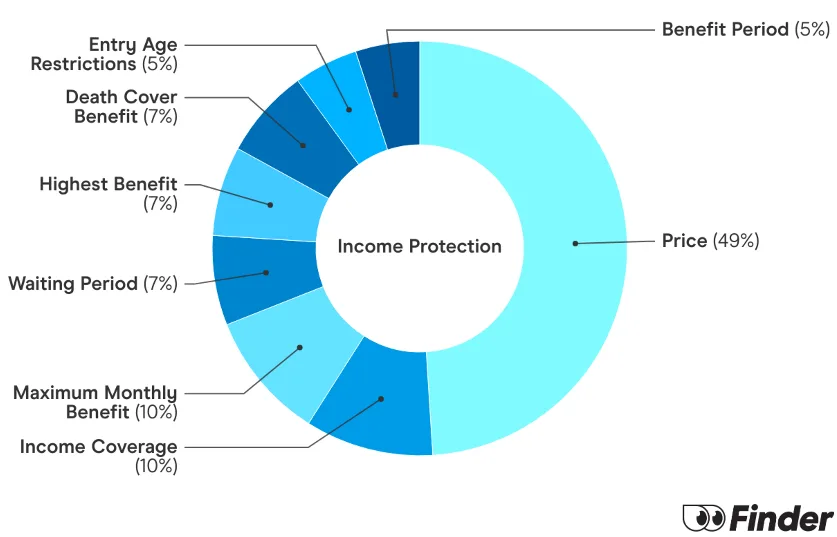Key takeaways
- Income protection payments are generally taxed in the same way your income is taxed.
- There are some differences based on what type of income protection you have, the payments you receive and your employment status.
- There are enough complications that it's probably best to speak to an accountant or financial advisor.
Are income protection payments taxed by the ATO?
Yes. If you receive income protection payments from a successful claim, you will need to declare it to the ATO. As a general rule of thumb, here's how income protection payments are taxed in Australia:
- Outside of super. Payouts are generally taxed (at the marginal rate) if your benefits are to replace lost income and the premiums were deductible.
- Inside of super. Trustees will usually apply a "withholding PAYG tax" from payouts for policies held inside super.
Keep in mind that if you are claiming multiple benefits for the same incident, typically only the benefits paid as an ongoing stream for income replacement purposes are tax assessable.
Compare income protection policies
The ATO allows for the premiums of income protection held outside of super, to be claimed as a tax deduction. You can use our comparison table and cover calculator below to find the right cover for you and claim the premiums back in your next tax declaration.
Compare other products
We currently don't have that product, but here are others to consider:
How we picked theseFinder Score - Income Protection
Income Protection is a little complicated and a lot overwhelming. That's why we made the Finder Score, to make it easier to compare Life Insurance products against each other. Our experts analysed over 12 products and gave each one a score rank out of 10.
But a higher score doesn't always mean a product is better for you. Your situation is unique, so your policy choice will be too. Don't think of Finder Score as the final word, but as a good place to start your life insurance comparison.
Are lump-sum income protection payments taxable?
Yes. In most cases, lump-sum income protection payments are taxed at your normal marginal tax rate. For a clearer idea of how much tax you will have to pay, you can use Finder's income tax calculator.
According to the ATO, you must declare any amount you have received for lost salary or wages under an income protection, sickness or accident insurance policy or workers compensation scheme.
The only time a payment might be tax-free is if you have made a personal injury claim and you agree to a settlement or a court orders in your favour and you receive compensation in the form of a lump-sum payment or periodic payment.
How are income protection payments taxed?
According to the ATO, "You must declare any amounts you received for lost salary or wages under an income protection, sickness or accident insurance policy or workers compensation scheme."
In other words, you'll need to pay tax on the monthly benefits you receive just like you would on your regular income. The amount of tax you pay is determined by the amount you earn per year and the resulting tax bracket you fit into.
2024-25 tax rates or Australian residents*
| Income threshold | Tax paid on income 2024/2025 |
|---|---|
| $0 – $18,200 | Nil |
| $18,201 – $45,000 | 16c for each $1 over $18,200 |
| $45,001 – $135,000 | $4,288 plus 30c for each $1 over $45,000 |
| $135,001 – $190,000 | $31,288 plus 37c for each $1 over $120,000 |
| $190,001 and over | $51,638 plus 45c for each $1 over $180,000 |
*This table does not include the Medicare levy of 2%.
2024-25 tax rates for foreign residents
Individuals who are foreign residents for tax purposes can still get income protection insurance in Australia and are subject to different tax rates. Foreign residents are not required to pay the Medicare levy, but may still be subject to the temporary budget repair levy.
Depending on the situation, foreign residents may be able to claim deductions for income protection insurance in similar ways.
| Income threshold | Tax paid on income 2023/2024 |
|---|---|
| 0 – $120,000 | 32.5c for each $1 |
| $120,001 – $180,000 | $39,000 plus 37c for each $1 over $120,000 |
| $180,001 and over | $61,200 plus 45c for each $1 over $180,000 |
How is income protection inside super taxed?
It's a little different, and more complicated, than taking out a standalone policy. In a nutshell, if you take out income protection through your superannuation fund,
- You will generally not be able to claim tax deductions for premiums and,
- The trustee of your super fund will apply withholding tax to benefit.
Speak to a tax specialist
The tax treatment can get more complicated in other ways, such as if you are not paying any of the premiums through superannuation contributions, are dividing premiums between super contributions and salary sacrifice, if your employer is making their own contributions to your premium payments, and other situations. Generally, you will not be able to claim your income protection premiums as a tax deduction, but you can expect Pay As You Go (PAYG) withholding tax to be applied to any benefit payments you receive from your policy.
Exceptions for self-employed workers
If you're self-employed, you may be able to claim your income protection insurance premiums as tax deductions even when held inside a superannuation policy. Because these premiums can be paid straight from before-tax superannuation contributions, this might work out to be an effective tax strategy. Note that premium payments for insurance policies held inside superannuation may still count towards the tax-free super contribution limit.
Is income protection tax-deductible?
Generally, yes. The (ATO) stipulates that you can claim the cost of any payment made for insurance that covers you in relation to loss of income. This means that income protection insurance premiums are usually tax-deductible, but only if you buy it as a standalone policy. For more clarification, we've broken it down into the two ways you can get income protection.
- Outside super. Premiums paid for income protection insurance policies held outside of superannuation are tax-deductible.
- Inside super. For funds inside super, it's a bit trickier. Insurance policies held inside superannuation are not tax-deductible when insurance premiums are deducted from your super contributions. Full tax deductions are only available for self-employed workers.
How is income protection taxed if you are self-employed?
- Premiums. Income protection premiums are normally tax-deductible. The ATO views any payment you have made towards your regular income as tax-deductible. Your monthly benefit payments will be assessed (and taxed) as regular income. Keep in mind though that you can't claim expenses on any payments or benefits of a capital, private or domestic nature (e.g. accident, illness or death cover).
- Payouts. Payouts are generally taxed (at the marginal rate) if your benefits are to replace lost income and the premiums were deductible.
When can fringe benefits tax be claimed for income protection?
Separate to income tax, fringe benefits tax is a business tax paid by employers on certain benefits they provide to their employees. Fringe benefits might include giving an employee permission to use a work car for private purposes or contributing to income protection insurance premiums for a policy taken out on an employee. Typically, fringe benefit tax for life insurance policies that a business has taken out on an employee will be taxable as a fringe benefit in line with the premiums the employee could have expected to pay themselves for the same policy.
When won't fringe benefits tax be payable?
Income protection insurance premiums might not be susceptible to fringe benefits tax where the "otherwise deductible" rule applies. Essentially, this means that when someone else could be claiming a deduction for the same expense, FBT will not apply to the relevant portion.
Consider this example where FBT will not apply at all:
Michael works for a construction company and decides to take out income protection cover. He is named as the life insured and the policy owner, but because Michael is a highly valuable employee, his boss decides to cover the cost of Michael's premiums too. In this instance, Michael's boss may not have to pay any FBT on the premiums because they would be otherwise deductible to Michael.
In addition, in cases where income protection cover is used as a type of key-person insurance and the benefit is used to replace the business's income, FBT is once again typically not payable.
Speak to an insurance specialist to help you find personalised cover
Frequently asked questions
Sources
Ask a question
8 Responses
More guides on Finder
-
HCF Income Protect Insurance
Wondering if HCF Income Protection Insurance is right for you? We break down what’s covered, what’s not and whether it offers good value.
-
Cost of living comparison
How much could you save if you lived in a different city in Australia? Let's find out.
-
Is income protection worth it?
Income protection can be a valuable form of cover for Australians when its features are fully understood.
-
Cost of income protection in Australia
Income protection costs can range from around $50 to $160+.
-
Sole trader income protection insurance
Income protection for sole traders provides financial support, via a monthly payment, if you’re unable to work due to illness or injury.
-
Income Protection Insurance vs Mortgage Protection
Does income protection provide the same thing as mortgage protection? Read on and compare.
-
Personal Accident Insurance vs Income Protection
Although income protection and personal accident cover both provide you with income replacement, there are key differences. Read on and compare.
-
Income Protection for Casual Workers
Find out when it is possible for part-time and casual workers to take out income protection insurance.
-
Income protection insurance calculator
Find out how much your income protection insurance policy will pay out in the event of a claim. Receive quotes for income protection and apply securely.
-
Best income protection, Australia
Looking for the best income protection insurance but not exactly sure where to start? Compare the Finder Awards 2025 insurance winners.



I have a friend who is tax resident in HK and has been for many years. His income protection policy was to insure income in HK. If this friend were to return to Australia and become and Australian tax resident, would these income protection policy payouts be assessable in Australia, given the policy was insuring a Hong Kong income?
Many thanks,
Karen
Hi Karen,
Thank you for getting in touch with Finder.
According to ATO’s income you pay tax on, an Australian resident must declare all income he earned anywhere in the world on his Australian tax return. It is best to speak to a tax agent on this specific situation for a more accurate info on this tax matter.
I hope this helps.
Thank you and have a wonderful day!
Cheers,
Jeni
I received income protection as a lump sum after waiting for the insurance company, as they were not going to pay, I received Newstart but I had to pay it all back. Is the income protection payout taxable income?
Hello Therese,
Thank you for your comment.
The ATO considers income protection to be tax deductible if it is paid under the policy to replace the loss of your income. ATO does not consider it to be tax deductible if it is paid under a policy to compensate for death, injury, or accident, such as under life insurance, trauma, or total permanent disability policy. This is also explained above.
You’re best to seek advice from a tax agent so they can provide you with a computation in case.
Should you wish to have real-time answers to your questions, try our chatbox on the lower right corner of our page.
Regards,
Jhezelyn
I have received a two year retrospective payment on an income protection claim against my insurer. My monthly payments for these two years were paid in a lump sum and the payments have continued every three months after the two years retrospective payment.
My question is whether I should pay tax in the financial year when I received the lump sum payment or should I pay tax based on the financial year related to the time period when the payments were claimed.
I was unable to work during the two years so the tax implications are significant.
Thanks for your advice
Michael
Hi Michael,
Thank you for getting in touch with Finder.
You must declare any amounts you received for lost salary or wages under income protection, sickness or accident insurance policy, or workers compensation scheme.
If you’ve made a personal injury claim and you agree to a settlement or a court order in your favour, you may receive compensation in the form of a lump-sum payment or structural (periodic) payments (or both). Such payments are tax-free, provided certain conditions are met.
You don’t include payments made to you under an income protection, sickness, or accident insurance policy (where the premiums are deductible and the payments replaced income) at this question, if:
You may want to know more about other income you need to declare on your tax return by checking out ATO’s compensation and insurance payments guide.
I hope this helps.
Have a great day!
Cheers,
Jeni
I have been paid an income protection benefit lump sum for 6 month period outside of super. How much tax would I need to factor into ny budget if given 19,000.00?
Hi Ruth,
Thanks for your inquiry.
We do have an income tax calculator, which you can use to get an idea of how much tax you will need to pay. Please feel free to use the calculator and read through the page as well as it comes with other related information.
Kind regards,
Rench